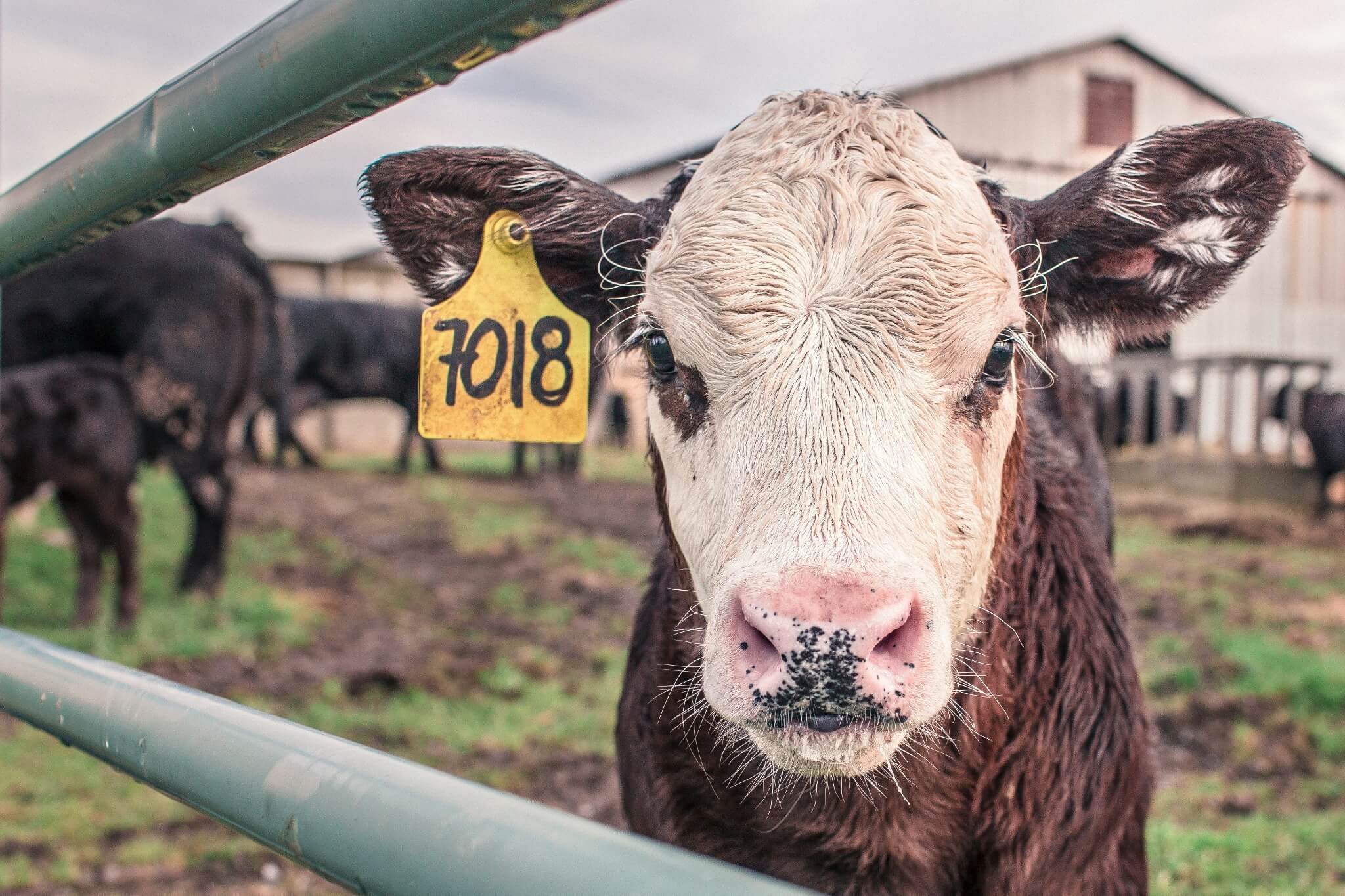In July 2018, the Orthodox Union (OU) announced that they will no longer certify as kosher any cattle slaughtered using the shackle and hoist method, which has been widely condemned as cruel.((Josefin Dolsten, “Orthodox Union to stop certifying kosher beef slaughtered using controversial method,” JTA, July 24, 2018, accessed August 13, 2018, https://www.jta.org/2018/07/24/top-headlines/orthodox-union-stop-certifying-kosher-beef-slaughtered-using-controversial-method. )) This victory is the result of years of hard work from the animal protection movement. The shackle and hoist method requires lifting fully conscious animals into the air by their hind legs and getting them into a position that exposes their neck to the shochet in order to make a kosher cut. Over the past 14 years, PETA has conducted multiple undercover investigations in kosher slaughterhouses to bring to light the cruelty of this practice.((“PETA Reveals Extreme Cruelty at Kosher Slaughterhouses,” PETA, accessed August 10, 2018, https://www.peta.org/features/agriprocessors/.)) The efforts they have spearheaded have resulted in two recent victories for animals. First, in November 2016, PETA & Anonymous for Animal Rights released an undercover investigation video((“Horrific Cruelty Filmed in Kosher Slaughterhouses,” PETA, accessed August 10, 2018, https://www.youtube.com/watch?v=KezHKbUzy0A.)) taken at a kosher plant in Paraguay, which supplies Israel with 40% of its beef,((“Israel mandates more humane slaughter methods for beef imports,” JTA, May 18, 2017, accessed August 13, 2018, https://www.jta.org/2017/05/18/news-opinion/israel-middle-east/israel-issues-new-guidelines-requiring-more-humane-ways-of-kosher-slaughter-on-imported-beef.)) displaying the inherent and indisputable cruelty of shackle and hoist handling. Following the release of this video, in May 2017 Israel’s Agricultural Ministry declared that it would no longer import any kosher beef slaughtered using the shackle and hoist method.((Sharon Udasin, “Israel Instructs Kosher Slaughterhouses to Stop ‘Shackle, Hoist’ Practice,” The Jerusalem Post, May 1, 2017, accessed August 8, 2018, https://www.jpost.com/Israel-News/Israel-instructs-kosher-slaughterhouses-to-stop-shackle-hoist-practice-492021.)) Second, earlier this year in response to Israel’s decision, the OU announced that it will no longer certify as kosher any beef from cattle that were shackled and hoisted.((Josefin Dolsten, “Orthodox Union to stop certifying kosher beef slaughtered using controversial method,” JTA, July 24, 2018, accessed August 13, 2018, https://www.jta.org/2018/07/24/top-headlines/orthodox-union-stop-certifying-kosher-beef-slaughtered-using-controversial-method.))
To fully appreciate the significance of these achievements, it is crucial to understand the history behind how shackle and hoist became an accepted practice for kosher slaughter. Prior to using the shackle and hoist method, an animal was generally held down on the floor while it was slaughtered by the shochet. When U.S. government meat inspectors first visited kosher plants, they were worried about the possible contamination of the blood from a previously slaughtered animal coming in contact with the next animal.((“‘Shackle and Hoist”: On Kosher Slaughter,’” Circle Aleph, April 16, 2010, accessed August 21, 2018, https://circlealeph.wordpress.com/2010/04/16/shackle-and-hoist/. )) To satisfy the U.S. government’s sanitary requirements and halakhic guidelines, shackling and hoisting became standard practice.
The Humane Methods of Slaughter Act (HMSA), passed in 1958, aimed to ban the practice of shackle and hoist without proper stunning beforehand.((“Chapter 48 – Humane Methods of Livestock Slaughter,” U.S. Government Publishing Office, accessed August 28, 2018, https://www.gpo.gov/fdsys/pkg/USCODE-2014-title7/pdf/USCODE-2014-title7-chap48.pdf. )) This sparked tensions between humane slaughter advocates and the kosher-observant Jewish community because kosher laws as presently interpreted require animals to be fully conscious and uninjured at slaughter. Early drafts of HMSA had deemed shechita, the kosher cut to the throat that ultimately kills the animal, as a humane method of slaughter, but this provision alone did not necessarily permit shackle and hoist slaughter. Shackling and hoisting in preparation for shechita is not strictly required by kosher law, and causes a conscious animal considerable distress. To make shackle and hoist kosher slaughter legal, two senators ended up adding a phrase indicating that not only was shechita to be permitted but that “the handling or other preparation of livestock for ritual slaughter” was to be permitted as well.((Roger Horowitz, Kosher USA: How Coke Became Kosher and Other Tales of Modern Food (New York: Columbia University Press, 2016), 211 – 242.)) This was, in essence, an exemption of religious slaughter from normal humane handling requirements. The above phrase gave religious slaughter a “ritual bubble,”((Bruce Friedrich, “Ritual Slaughter in the “Ritual Bubble”: Restoring the Wall of Separation Between Church and State,” Vermont Journal of Environmental Law 17 (2015).)) deeming any and all handling before slaughter, including shackling and hoisting, legal and humane. Humane advocates were not pleased with this exemption, but nevertheless the bill was pushed through.
At the time, this exemption made some sense, as there were no alternative slaughter methods that met both halakhic and government sanitary requirements.((The Committee on Jewish Law and Standards of the Conservative Movement, “Shackling and Hoisting,” The Rabbinical Assembly, (2002), https://www.grandin.com/ritual/conservative.jewish.law.html.)) Yet in 1964, the “upright pen” was developed by the ASPCA, which both abided by kosher slaughter guidelines and was comparatively much more humane, as cattle could be kept upright and remain calm before slaughter.((Diane Beers, “For the Prevention of Cruelty: The History and Legacy of Animal Rights Activism in the United States,” (Ohio: Swallow Press/Ohio University Press, 2006), 159-167.)) Due to the ritual bubble written in the HMSA, kosher plants were not obligated to switch to the upright pens, but in the 1970s Temple Grandin stepped in to assist kosher slaughter plants in making the transition to the upright pens and many of them obliged.
Unfortunately, less than a decade after many plants had switched to the upright pens, three large firms took control of the meat production in the U.S. and the landscape shifted to larger, more intensive operations, putting almost all small kosher plants out of business. As a result, kosher meat distributors turned to Central and South America for their source of kosher beef where the shackle and hoist method was prevalent.((Roger Horowitz, Kosher USA: How Coke Became Kosher and Other Tales of Modern Food (New York: Columbia University Press, 2016), 211 – 242.)) This has meant that until recently, cattle destined for the kosher market in the US often experienced some of the worst abuses and suffering possible during slaughter.
The upright pen, also known as the ASPCA pen, keeps cattle in an upright position so that they remain much more calm prior to slaughter.((Temple Grandin, “ASPCA Pen,” updated September 2010, accessed September 12, 2018, https://www.grandin.com/ritual/aspca.html.))
Farm Forward, JIFA’s parent organization, has been involved in the efforts to find alternatives to shackle and hoist—and keep consumers in the know about the issue—since its inception. Farm Forward founder and CEO, Dr. Aaron Gross, has consulted with both animal groups like PETA and industry professionals in his capacity as a Jewish studies expert, with the aim of finding ways to meet Jewish legal requirements and reduce animal suffering as much as possible. He argues, “The fact that shackle and hoist remained a common method for the kosher slaughter of cattle for so long was not only bad for animals, but also bad for Jewish ethics and for the reputation of the kosher industry. The OU’s decision to finally end this embarrassment is an important victory for animals and for the Jewish community. There is still much work needed—almost all kosher meat still comes from factory farms—but this is a step forward that matters and that will reduce considerable animal suffering.” After the OU’s announcement, Rabbi Menachem Genack, the head of kashrut for the OU said, “The OU for a very long time has been focused on this, trying to promote slaughter in the [rotating] pen of beef, so we’re happy that Israel took that step.”((Josefin Dolsten, “Orthodox Union to stop certifying kosher beef slaughtered using controversial method,” JTA, July 24, 2018, accessed August 13, 2018, https://www.jta.org/2018/07/24/top-headlines/orthodox-union-stop-certifying-kosher-beef-slaughtered-using-controversial-method.)) At JIFA, we are encouraged by and share in the Jewish community’s public enthusiasm for these changes.
The rotating pen Rabbi Genack refers to is an alternative to both shackle and hoist and the upright pen. The rotating pen rotates the animal partially, unlike the upright pen that lifts the animal up from its belly. This is a significant improvement over shackle and hoist, but still not optimal welfare for kosher slaughter. The reason these rotating pens are used instead of the upright pens is due to an argument among rabbis about whether the upward cut required by the upright pen violates derashah, the rule that prohibits putting extra pressure on the knife during the cut for shechita if the animal were to push downwards on the blade. Temple Grandin and the eminent rabbi Moshe Feinstein both claimed that no extra pressure was in fact necessary if the animal’s head was properly restrained.((Temple Grandin and Joe Regenstein, “Religious slaughter and animal welfare: a discussion for meat scientists,” Meat Focus International, March 1994, accessed October 16, 2018, https://www.grandin.com/ritual/kosher.slaugh.html.)),((Roger Horowitz, Kosher USA: How Coke Became Kosher and Other Tales of Modern Food (New York: Columbia University Press, 2016), 233.)) However, some rabbinical authorities, including Israel’s chief rabbinate, have argued otherwise and thus the rotating pens have continued to be used in plants that want to sell their meat in Israel.
For many Jews, a kosher certification implies higher welfare and less animal suffering. Yet almost all animals raised for food today—kosher and non-kosher—come into this world genetically prone to suffer and live their lives confined on factory farms, some never even seeing the light of day. Unfortunately, today, a kosher certification doesn’t typically mean animals are spared inhumane raising, handling, and slaughter practices, but it is possible for this to change. The kosher industry is well poised to distinguish itself from the factory farming industry that co-opted it only decades ago.
JIFA applauds the Israeli Agricultural Ministry and the Orthodox Union’s commitments to withdraw their support from one of the most gruesome methods of slaughter practiced today. And we thank those in the animal protection movement who fought for this change. Changes like this do not happen because industries, whether the kosher industry or others, suddenly decide to do the right thing. Change happens through hard work to create the pressure that finally forces industry to act. It took more than a decade of work to make this change happen and, above all, we applaud the handful of animal advocates who quietly worked, without recognition, to make it a reality; your hard work made this possible.

Dairy Dilemma: The Buzz on Biogas
Dairy farming poses several environmental challenges, especially with the expansion of mega-dairies. As Shavu’ot approaches, JIFA talks with Trevor McCarty, Policy Manager at Farm Forward, about the role of biogas digesters in dairy farming and their implications for consumers and communities.



